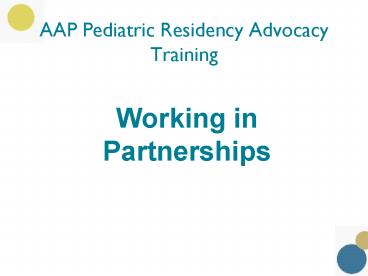AAP Pediatric Residency Advocacy Training
1 / 10
Title:
AAP Pediatric Residency Advocacy Training
Description:
Building Strength in Numbers ... Strength in numbers is one of the best ways to ... Building strength in numbers helps demonstrate to decision-makers that ... –
Number of Views:40
Avg rating:3.0/5.0
Title: AAP Pediatric Residency Advocacy Training
1
AAP Pediatric Residency Advocacy Training
Working in Partnerships
2
Introduction
- Sometimes its easy to assume that just because
were on the right side of an issuesuch as
childrens healthwe will win. - Unfortunately, being right in and of itself will
not yield victory. - Working in partnerships will help multiply the
power of your advocacy efforts and build strength
in numbers. - Working in partnerships includes getting other
individuals, organizations, alliances, and
coalitions involved to accomplish your advocacy
goal.
3
Building Strength in Numbers
- As a pediatrician, you are both a credible and
natural advocate for children and your
profession. - However, even with compelling issues, a powerful
story and ongoing advocacy, there is a greater
chance of winning when you build strength in
numbers. - There are two ways to build strength in numbers
- 1.) Getting more people involved.
- 2.) Getting more organizations involved.
4
Why Get More People Involved
- Generates hope and excitement for your issue.
The more others see they are not alone, the more
they will be willing to advocate and believe that
a broader solution is possible. - More people bring a broader set of skills,
knowledge, and contacts. - More people means increased pressure on
decision-makers to act. - Opposition to our issues frequently emerges.
Strength in numbers is one of the best ways to
counter it.
5
A Note on Opposition
- When working on issues as important as childrens
health, it can be hard to imagine why others
wouldnt support your issue, much less oppose it.
- However, your issue will almost always be
competing with other issues for resources or may
reflect a different view of the best way to
address the issue. Understanding the differences
may help you find common ground. - Building strength in numbers helps demonstrate to
decision-makers that childrens health and
well-being are a priority and support for your
issue is larger and more powerful than any
potential oppositions interests.
6
How to Get More People Involved
- Recognize that some people may be hesitant to get
involved because they are unfamiliar with
advocacy. - Start with people you already know who care about
children. - Ask peoplea natural and acceptable thing to do
- Connect your issue to others self-interests.
- Convey why your issue is important and why their
help is needed. - Have a concrete request and be clear about the
time commitment.
7
Why Get More Organizations Involved
- Demonstrates that the issue has visible and
wide-ranging support. - Decision-makers more likely to respond to
broader-based support. - Organizations bring more resources (people,
skills, connections).
8
How to Get Organizations Involved
- Choose organizations with common interests.
- Understand the organizations processes.
- Balance resources against the challenges.
- Dont forget about untraditional allies.
9
Making a Difference
- Getting more individuals and groups involved
helps us win on the issues that are important to
us. - Working in partnerships helps us increase the
number of people and groups working in improve
childrens health and wellbeing and builds
strength in numbers. - When working with otherswhether it is an
individual or a grouptry to understand their
motivations and interests. - Remember that partnerships can include the usual
suspects as well as unlikely partners. The only
way to know if someone will support your issue is
by asking.
10
Additional Resources and Information
- AAP Advocacy Guide (www.aap.org/moc/advocacyguide)
- AAP Chapters (www.aap.org/member/chapters/chapters
.htm) - AAP Division of State Government Affairs
(www.aap.org/moc/stgovaffairs) - AAP Department of Federal Affairs
(www.aap.grassroots.com) - AAP Community Pediatrics Training Initiative
(www.aap.org/commpeds/CPTI)































